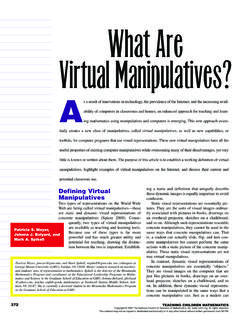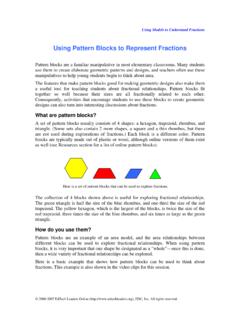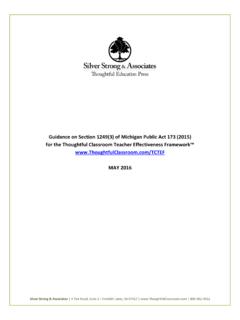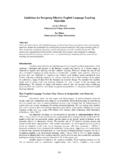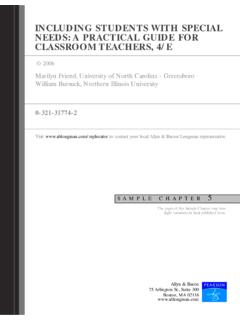Transcription of 63 3 Assessment to Promote Learning Pages 10-17 Seven ...
1 November 2005 November 2005 | Volume 63 | Number 3 Assessment to Promote Learning Pages 10-17 Seven Practices for Effective LearningTeachers in all content areas can use these Seven Assessment and grading practices to enhance Learning and McTighe and Ken O'ConnorClassroom Assessment and grading practices have the potential not only to measure and report Learning but also to Promote it. Indeed, recent research has documented the benefits of regular use of diagnostic and formative assessments as feedback for Learning (Black, Harrison, Lee, Marshall, & Wiliam, 2004). Like successful athletic coaches, the best teachers recognize the importance of ongoing assessments and continual adjustments on the part of both teacher and student as the means to achieve maximum performance.
2 Unlike the external standardized tests that feature so prominently on the school landscape these days, well-designed classroom Assessment and grading practices can provide the kind of specific, personalized, and timely information needed to guide both Learning and assessments fall into three categories, each serving a different purpose. Summative assessments summarize what students have learned at the conclusion of an instructional segment. These assessments tend to be evaluative, and teachers typically encapsulate and report Assessment results as a score or a grade. Familiar examples of summative assessments include tests, performance tasks, final exams, culminating projects, and work portfolios.
3 Evaluative assessments command the attention of students and parents because their results typically count and appear on report cards and transcripts. But by themselves, summative assessments are insufficient tools for maximizing Learning . Waiting until the end of a teaching period to find out how well students have learned is simply too other classroom Assessment categories diagnostic and formative provide fuel for the teaching and Learning engine by offering descriptive feedback along the way. Diagnostic assessments sometimes known as pre-assessments typically precede instruction. Teachers use them to check students' prior knowledge and skill levels, identify student misconceptions, profile learners' interests, and reveal Learning -style preferences.
4 Diagnostic assessments provide information to assist teacher planning and guide differentiated instruction. Examples of diagnostic assessments include prior knowledge and skill checks and interest or Learning preference surveys. Because pre-assessments serve diagnostic purposes, teachers normally don't grade the assessments occur concurrently with instruction. These ongoing assessments provide specific feedback to teachers and students for the purpose of guiding teaching to improve Learning . Formative assessments include both formal and informal methods, such as ungraded quizzes, oral questioning, teacher observations, draft work, think-alouds, student-constructed concept maps, Learning logs, and portfolio reviews.
5 Although teachers may record the results of formative assessments, we shouldn't factor these results into summative evaluation and these three categories of classroom Assessment in mind, let us consider Seven specific Assessment and grading practices that can enhance teaching and 1: Use summative assessments to frame meaningful performance the first day of a three-week unit on nutrition, a middle school teacher describes to students the two summative assessments that she will use. One Assessment is a multiple-choice test examining student knowledge Copyright (c) 2005 by Association for Supervision and Curriculum Developmentof various nutrition facts and such basic skills as analyzing nutrition labels.
6 The second Assessment is an authentic performance task in which each student designs a menu plan for an upcoming two-day trip to an outdoor education facility. The menu plan must provide well-balanced and nutritious meals and current emphasis on established content standards has focused teaching on designated knowledge and skills. To avoid the danger of viewing the standards and benchmarks as inert content to cover, educators should frame the standards and benchmarks in terms of desired performances and ensure that the performances are as authentic as possible. Teachers should then present the summative performance Assessment tasks to students at the beginning of a new unit or practice has three virtues.
7 First, the summative assessments clarify the targeted standards and benchmarks for teachers and learners. In standards-based education, the rubber meets the road with assessments because they define the evidence that will determine whether or not students have learned the content standards and benchmarks. The nutrition vignette is illustrative: By knowing what the culminating assessments will be, students are better able to focus on what the teachers expect them to learn (information about healthy eating) and on what they will be expected to do with that knowledge (develop a nutritious meal plan).
8 Second, the performance Assessment tasks yield evidence that reveals understanding. When we call for authentic application, we do not mean recall of basic facts or mechanical plug-ins of a memorized formula. Rather, we want students to transfer knowledge to use what they know in a new situation. Teachers should set up realistic, authentic contexts for Assessment that enable students to apply their Learning thoughtfully and flexibly, thereby demonstrating their understanding of the content , presenting the authentic performance tasks at the beginning of a new unit or course provides a meaningful Learning goal for students.
9 Consider a sports analogy. Coaches routinely conduct practice drills that both develop basic skills and purposefully point toward performance in the game. Too often, classroom instruction and Assessment overemphasize decontextualized drills and provide too few opportunities for students to actually play the game. How many soccer players would practice corner kicks or run exhausting wind sprints if they weren't preparing for the upcoming game? How many competitive swimmers would log endless laps if there were no future swim meets? Authentic performance tasks provide a worthy goal and help learners see a reason for their 2: Show criteria and models in high school language arts teacher distributes a summary of the summative performance task that students will complete during the unit on research, including the rubric for judging the performance's quality.
10 In addition, she shows examples of student work products collected from previous years (with student names removed) to illustrate criteria and performance levels. Throughout the unit, the teacher uses the student examples and the criteria in the rubric to help students better understand the nature of high-quality work and to support her teaching of research skills and report second Assessment practice that supports Learning involves presenting evaluative criteria and models of work that illustrate different levels of quality. Unlike selected-response or short-answer tests, authentic performance assessments are typically open-ended and do not yield a single, correct answer or solution process.
